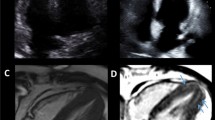Abstract
Regadenoson Stress Echocardiography (RSE) can detect myocardial ischemia, and its diagnostic accuracy should be evaluated. We sought to investigate the agreement between RSE and gated-SPECT myocardial perfusion imaging (MPI) and appraise its diagnostic accuracy. Consecutive patients (n = 202) referred for non-invasive evaluation of myocardial ischemia, with (38.6%) or without a previous coronary artery disease (CAD) diagnosis, were enrolled. Both tests were performed simultaneously. Invasive coronary angiography (CA) is considered the gold standard. The mean age was 70.9 (9.8) years, and 59.9% were male. The prevalence of cardiovascular risk factors (arterial hypertension [81.7%], diabetes mellitus [37.6%], hypercholesterolemia [71.8%], and smoking [18.8%]) was high. Forty-four patients (21.8%) had a non-interpretable electrocardiogram, 15 (34.1%) of them were a result of ventricular paced-rhythm, while 29 (65.9%) were a result of advanced left ventricular branch block. The overall agreement between both diagnostic techniques was good: Gwet’s AC1 0.66 (CI95% 0.55 to 0.76), and it was higher in patients without a previous CAD diagnosis: 0.76 (CI95% 0.65 to 0.87). In the biased sample (those who underwent CA), RSE and nuclear study sensitivity was 0.50 and 0.78 and specificity was 0.75 and 0.75, respectively. We noted a dramatic reduction in sensitivity for RSE after debiasing (debiased sensitivity of 0.16), and the negative predictive value was similar to the biased and debiased samples. RSE is in strong agreement with gated-SPECT MPI. However, its low sensitivity and negative predictive value preclude its use as a bedside test to detect myocardial ischemia.

Similar content being viewed by others
Data availability
The dataset used in this study can be retrieved in: Iglesias-Garriz, Ignacio (2020), “Regadenoson stress echo and gated-SPECT, phase 2.”, Mendeley Data, V2, https://doi.org/10.17632/8vkpcz8wxd.2.
References
Al Jaroudi W, Iskandrian AE (2009) Regadenoson: a new myocardial stress agent. J Am Coll Cardiol 54:1123–1130. https://doi.org/10.1016/j.jacc.2009.04.089
Iskandrian AE, Bateman TM, Belardinelli L et al (2007) Adenosine versus regadenoson comparative evaluation in myocardial perfusion imaging: Results of the ADVANCE phase 3 multicenter international trial. J Nucl Cardiol 14:645–658. https://doi.org/10.1016/j.nuclcard.2007.06.114
Mahmarian JJ, Cerqueira MD, Iskandrian AE et al (2009) Regadenoson induces comparable left ventricular perfusion defects as adenosine. JACC Cardiovasc Imaging 2:959–968. https://doi.org/10.1016/j.jcmg.2009.04.011
Le DE, Bragadeesh T, Zhao Y et al (2011) Detection of coronary stenosis with myocardial contrast echocardiography using regadenoson, a selective adenosine A2A receptor agonist. Eur Hear J 13:298–308. https://doi.org/10.1093/ejechocard/jer232
Mary RPT, HR AR et al (2011) Rapid detection of coronary artery stenoses with real-time perfusion echocardiography during regadenoson stress. Circ Cardiovasc Imaging 4:628–635. https://doi.org/10.1161/CIRCIMAGING.111.966341
Holly TA, Abbott BG, Al-Mallah M et al (2010) Single photon-emission computed tomography. J Nucl Cardiol 17:941–973. https://doi.org/10.1007/s12350-010-9246-y
Wongpakaran N, Wongpakaran T, Wedding D, Gwet KL (2013) A comparison of Cohen’s Kappa and Gwet’s AC1 when calculating inter-rater reliability coefficients: a study conducted with personality disorder samples. BMC Med Res Methodol 13:61. https://doi.org/10.1186/1471-2288-13-61
Begg CB, Greenes RA (1983) Assessment of diagnostic tests when disease verification is subject to selection bias. Biometrics 39:207–215. https://doi.org/10.2307/2530820
Stillman AE, Oudkerk M, Bluemke DA et al (2018) Imaging the myocardial ischemic cascade. Int J Cardiovasc Imaging 34:1249–1263. https://doi.org/10.1007/s10554-018-1330-4
Pellikka PA, Arruda-Olson A, Chaudhry FA et al (2020) Guidelines for performance, interpretation, and application of stress echocardiography in ischemic heart disease: from the American Society of Echocardiography. J Am Soc Echocardiogr 33:1-41.e8. https://doi.org/10.1016/j.echo.2019.07.001
Kim M-N, Kim S-A, Kim Y-H et al (2016) Head to head comparison of stress echocardiography with exercise electrocardiography for the detection of coronary artery stenosis in women. J Cardiovasc Ultrasound 24:135–143
Abdelmoneim SS, Mulvagh SL, Xie F et al (2015) Regadenoson stress real-time myocardial perfusion echocardiography for detection of coronary artery disease: feasibility and accuracy of two different ultrasound contrast agents. J Am Soc Echocardiogr 28:1393–1400. https://doi.org/10.1016/j.echo.2015.08.011
Shaikh K, Wang DD, Saad H et al (2014) Feasibility, safety and accuracy of regadenoson–atropine (REGAT) stress echocardiography for the diagnosis of coronary artery disease: an angiographic correlative study. Int J Cardiovasc Imaging 30:515–522. https://doi.org/10.1007/s10554-014-0363-6
Caiati C, Lepera ME, Carretta D et al (2013) Head-to-head comparison of peak upright bicycle and post-treadmill echocardiography in detecting coronary artery disease: a randomized, single-blind crossover study. J Am Soc Echocardiogr 26:1434–1443. https://doi.org/10.1016/j.echo.2013.08.007
Peteiro J, Bouzas-Mosquera A, Estevez R et al (2012) Head-to-head comparison of peak supine bicycle exercise echocardiography and treadmill exercise echocardiography at peak and at post-exercise for the detection of coronary artery disease. J Am Soc Echocardiogr 25:319–326. https://doi.org/10.1016/j.echo.2011.11.002
Danilo N, Daniele R, Chiara C et al (2015) Detection of significant coronary artery disease by noninvasive anatomical and functional imaging. Circ Cardiovasc Imaging 8:e002179. https://doi.org/10.1161/CIRCIMAGING.114.002179
van Stralen KJ, Stel VS, Reitsma JB et al (2009) Diagnostic methods I: sensitivity, specificity, and other measures of accuracy. Kidney Int 75:1257–1263. https://doi.org/10.1038/ki.2009.92
Jazmati B, Sadaniantz A, Emaus SP, Heller GV (1991) Exercise thallium-201 imaging in complete left bundle branch block and the prevalence of septal perfusion defects. Am J Cardiol 67:46–49. https://doi.org/10.1016/0002-9149(91)90097-5
Acknowledgements
We are indebted to Concepción Gonzalez-Anton, Silvia Marcos-Rey, and Monica Dominguez-Barriales for their excellent nursing care of the patients during the stress studies.
Funding
None.
Author information
Authors and Affiliations
Contributions
All authors contributed to the study conception and design. The first draft of the manuscript was written by the first author and all the contributors commented on previous versions of the manuscript. All authors read and approved the final manuscript.
Corresponding author
Ethics declarations
Conflict of interest
The authors do not declare any conflict of interest related to this research.
Ethical approval
Approval was obtained from the ethics committee of our institution. The procedures used in this study adhere to the tenets of the Declaration of Helsinki.
Informed consent
Informed consent was obtained from all individual participants included in the study.
Additional information
Publisher's Note
Springer Nature remains neutral with regard to jurisdictional claims in published maps and institutional affiliations.
Rights and permissions
About this article
Cite this article
Iglesias-Garriz, I., Vara-Manso, J., Sevilla, A. et al. Diagnostic accuracy of regadenoson stress echocardiography: concordance with gated-spect myocardial perfusion imaging. Int J Cardiovasc Imaging 37, 509–515 (2021). https://doi.org/10.1007/s10554-020-02033-x
Received:
Accepted:
Published:
Issue Date:
DOI: https://doi.org/10.1007/s10554-020-02033-x




